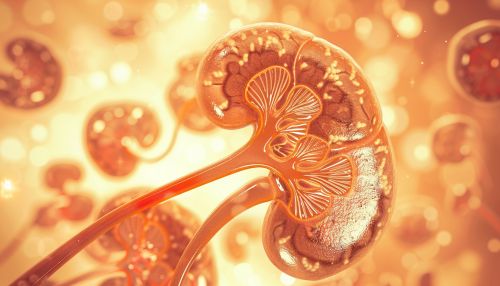Kidney Diseases
Overview
Kidney diseases encompass a broad range of conditions that affect the normal functioning of the kidneys. These organs play a critical role in the body's homeostatic processes, including the regulation of electrolytes, maintenance of acid-base balance, and control of blood pressure. Kidney diseases can be acute or chronic, with varying degrees of severity and potential complications.


Classification of Kidney Diseases
Kidney diseases can be broadly classified into five categories: glomerular diseases, tubulointerstitial diseases, vascular diseases, cystic diseases, and urinary tract infections. Each of these categories includes several specific conditions, each with its unique pathophysiology, clinical presentation, and treatment options.
Glomerular Diseases
Glomerular diseases affect the glomeruli, the tiny filtering units of the kidney. These diseases can be primary, where the disease only affects the kidneys, or secondary, where the disease is a result of another illness such as diabetes or lupus. Examples of glomerular diseases include glomerulonephritis and nephrotic syndrome.
Tubulointerstitial Diseases
Tubulointerstitial diseases involve the renal tubules and interstitium, the tissue surrounding the tubules. These diseases often result in acute or chronic kidney failure. Examples include acute tubular necrosis, interstitial nephritis, and polycystic kidney disease.
Vascular Diseases
Vascular diseases affect the blood vessels within the kidneys, disrupting the normal blood flow. This disruption can lead to hypertension and kidney failure. Examples include renal artery stenosis and renovascular hypertension.
Cystic Diseases
Cystic diseases are characterized by the formation of fluid-filled sacs, or cysts, within the kidneys. These cysts can disrupt normal kidney function and lead to kidney failure. The most common cystic disease is polycystic kidney disease.
Urinary Tract Infections
Urinary tract infections (UTIs) are infections that can occur anywhere along the urinary tract, including the kidneys. When a UTI affects the kidneys, it is known as pyelonephritis.
Pathophysiology of Kidney Diseases
The pathophysiology of kidney diseases involves various mechanisms, depending on the specific disease. However, most kidney diseases involve some degree of damage to the nephrons, the functional units of the kidney. This damage can result in decreased kidney function, leading to the accumulation of waste products in the blood and various other complications.
Symptoms and Diagnosis
The symptoms of kidney diseases can vary widely, depending on the specific disease and its severity. Common symptoms include fatigue, changes in urine output, fluid retention, and back pain. Diagnosis typically involves a combination of patient history, physical examination, laboratory tests, and imaging studies.
Treatment and Management
The treatment and management of kidney diseases depend on the specific disease and its severity. Treatment options may include medication, lifestyle changes, dialysis, or kidney transplantation. The goal of treatment is to manage symptoms, slow the progression of the disease, and prevent complications.
Prognosis
The prognosis for individuals with kidney disease depends on the specific disease, its severity, and the individual's overall health. Some kidney diseases can be managed effectively with treatment, while others may eventually lead to kidney failure and require dialysis or transplantation.
Prevention
Prevention strategies for kidney diseases often involve managing risk factors, such as maintaining a healthy weight, controlling blood pressure and blood sugar levels, and avoiding exposure to certain toxins and medications that can damage the kidneys.
